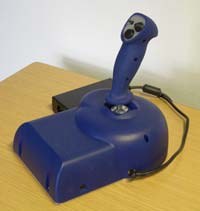Force-Feedback Joystick (2003–2010)

Numerous simple command tasks in telerobotics and telepresence can be accomplished with human machine interfaces with a maximum of two or three degrees of freedom (DoF). For this kind of applications the joystick represents a very intuitive way to command a teleoperator or an object within a virtual environment in two DoF. This type of human machine interface became more popular after being used as a command input in PC games. In the last years the functionality of joystick systems has been expanded by adding electric actuators to the joystick axes, enabling in this way force feedback commands to the operators hand and thus a more precise and intuitive command issue.
Objectives: The goal of our development works concerning force feedback joysticks was to obtain a high fidelity haptic display with two DoF which allows a very realistic force display.
The mechatronic solution adopted for the force exertion was to add a drive combination of ironless DC brushed motors and cable gears to the cardanic joint of the joystick axes. This approach allows changeability of different force levels by adapting the motor-gear combination.
To obtain high accuracy the position in both joystick axes is measured by high resolution encoders and the motors have ironless and sloped windings. The power electronics assure a very precise current control in both axes with very high chopping rates.
